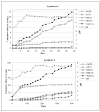Release of arsenic to the environment from CCA-treated wood. 2. Leaching and speciation during disposal
- PMID: 16509348
- PMCID: PMC2556044
- DOI: 10.1021/es051471u
Release of arsenic to the environment from CCA-treated wood. 2. Leaching and speciation during disposal
Abstract
Wood treated with chromated copper arsenate (CCA) is primarily disposed within construction and demolition (C&D) debris landfills, with wood monofills and municipal solid waste (MSW) landfills as alternative disposal options. This study evaluated the extent and speciation of arsenic leaching from landfills containing CCA-treated wood. In control lysimeters where untreated wood was used, dimethylarsinic acid (DMAA) represented the major arsenic species. The dominant arsenic species differed in the lysimeters containing CCA-treated wood, with As(V) greatest in the monofill and C&D lysimeters and As(III) greatest in the MSW lysimeters. In CCA-containing lysimeters, the organoarsenic species monomethylarsonic acid (MMAA) and DMAAwere virtually absent in the monofill lysimeter and observed in the C&D and MSW lysimeters. Overall arsenic leaching rate varied for the wood monofill (0.69% per meter of water added), C&D (0.36% per m), and MSW (0.84% per m) lysimeters. Utilizing these rates with annual disposal data, a mathematical model was developed to quantify arsenic leaching from CCA-treated wood disposed to Florida landfills. Model findings showed between 20 and 50 t of arsenic (depending on lysimeter type) had leached prior to 2000 with an expected increase between 350 and 830 t by 2040. Groundwater analysis from 21 Florida C&D landfills suspected of accepting CCA-treated wood showed that groundwater at 3 landfills was characterized by elevated arsenic concentrations with only 1 showing impacts from the C&D waste. The slow release of arsenic from disposed treated wood may account for the lack of significant impact to groundwater near most C&D facilities at this time. However, greater impacts are anticipated in the future given that the maximum releases of arsenic are expected by the year 2100.
Figures





Comment in
-
Arsenic-treated wood may have a toxic legacy.Environ Sci Technol. 2006 Feb 1;40(3):634-5. Environ Sci Technol. 2006. PMID: 16509292 No abstract available.
-
Comment on "Release of arsenic to the environment from CCA-treated wood. 2. Leaching and speciation during disposal".Environ Sci Technol. 2006 Aug 1;40(15):4809-10; author reply 4811-2. doi: 10.1021/es060601b. Environ Sci Technol. 2006. PMID: 16913143 No abstract available.
-
Comment on "release of arsenic to the environment from CCA-treated wood. 2. Leaching and speciation during disposal".Environ Sci Technol. 2007 Jan 1;41(1):345-6. doi: 10.1021/es061792l. Environ Sci Technol. 2007. PMID: 17265969 No abstract available.
References
-
- Townsend TG, Solo-Gabriele HM, Tolaymat T, Stook K. Impact of chromated copper arsenate (CCA) in wood mulch. The Science of the Total Environment. 2003;309:173–185. - PubMed
-
- Solo-Gabriele H, Townsend T. Disposal practices and management alternatives for CCA-treated wood waste. Waste Management Research. 1999;17:378–389.
-
- Solo-Gabriele HM, Townsend T, Messick B, Calitu V. Characteristics of chromated copper treated – wood ash. Journal of Hazardous Materials. 2001;89(2–3):213–232. - PubMed
-
-
Florida Department of Environmental Protection (FDEP). Florida Administrative Code, Solid Waste Management Facilities, Chapter 62, Section 701. FDEP, Tallahassee, FL, 2004.
-
-
- Townsend T, Tolaymat T, Solo-Gabriele H, Dubey B, Stook K, Wadanambi L. Leaching of CCA treated wood: implications for waste disposal. Journal of Hazardous Materials. 2004;B114(2004):75–91. - PubMed
Publication types
MeSH terms
Substances
Grants and funding
LinkOut - more resources
Full Text Sources
Medical
Research Materials

